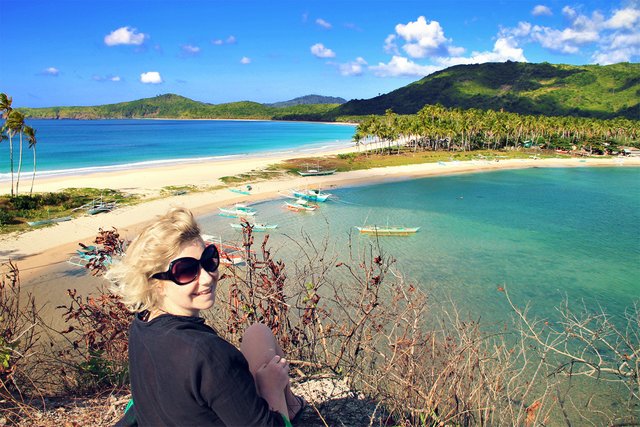Moving To The Philippines, My Story for Steemiters!
I would like to become part of this beautiful site :)

In August, 2015, my spouse and I retired and relocated overseas from the U.S to the Philippines. As you will see, doing so was not an easy undertaking, and at first I was reluctant to even consider the notion. But thanks to my determined wife, good timing and fortune, and a lot of logistical help from our families, this turned out to be one of the smartest decisions of my life. And because I like to share information about prospective opportunities, I wrote the following narrative about this move.
This story begins in the early part of the decade. My wife Lydia and I were living a modest but comfortable life style, but our careers were at a dead end. I hated my job, but I was making a good wage and had important fringe benefits such as health insurance that were too valuable to give up and start over again.

Then there was the age factor. I was almost 60, so it was unlikely that I would find new employment that would match my salary and benefits at the time—that is if I could find any work at all. Legal or not, age discrimination in the U.S. is a serious concern. Of course, employers who practice this bias usually do so discreetly. For example, to get around the prohibition against asking an applicant for his/her age, the prospective employer will ask for a copy of the job-seeker’s driver’s license for “identity confirmation”. And a salient feature on that form ID of course is date of birth.
Meanwhile, Lydia’s problem with her work was over-qualification for her job. When she was already middle-aged, she earned a B.A. and an M.A degree in psychology. Yet, despite these achievements, the only work that she could find was the position of pre-school teacher, based on her other degree in education (more age discrimination?).
And both of us had long commutes to and from work. Mine ranged from 1½ to 2 hours each way (about 55 miles). Lydia’s was even longer. This meant leaving home about 5am and not returning till about 7pm. For us the notion of an eight-hour work day was a joke.
Whenever Lydia and I are faced with an extraordinary problem for which there just doesn’t seem to be a suitable cure using ordinary solutions, her favorite expression is “then what?” Believe me, if ever there were a “then what?” state of affairs, this was it. It was time to get creative and think outside the box.
Little did I know that Lydia had already hatched a plan that she had actually started putting together in 2001, but it involved taking a big chance, and knowing my risk-aversive nature, she held off telling me until she had thought it through to the smallest detail. Even so, when she first dropped it on me in 2003, it took several months for me to buy into it. But when I did, there was no turning back.
What Lydia proposed for us was truly the great escape: Taking early retirement and moving to the Philippines, her country of origin. On the face of it this sounded like an impossible dream. We were in debt and had no assets to sustain ourselves if we stopped working. We were renters, so we didn’t own property that we could sell to liquidate our debts and live off the remaining proceeds. How then could we possibly make this cockamamie idea work?
The first thing that Lydia did after revealing her ideas was to quit her job and apply for social security for which she had recently become eligible. As counterproductive as that might sound, after factoring in work related expenses such as commuting, she determined that the difference between her salary and S.S. income was minimal and more than compensated for by the newly available free time needed to attend to the details that would put her plan into action, such as packing and shipping.
Before I became fully supportive of this move, I had considered hedging our bet by leaving our furniture in storage in the U.S. while we tested the waters of life in the Philippines. Eventually, I gave up that idea. If Lydia’s plan was going to work, I had to be totally on board and fully committed.
I have to acknowledge that in planning a relocation to the Philippines, we had a few home court advantages. We qualified for a special permanent resident visa program extended to former Philippine citizens and their foreign spouses. These forms are known as the 13(g) and the 13(a). As for shipping our possessions, it so happens that we were familiar with a freight service called LBC that specializes in shipments to the Philippines, and like Fed-Ex (but not as expensive), the sender can arrange for a scheduled pickup, which of course is an extremely convenient feature. (This is not a paid advertisement, just personal experience.)
Due to size restrictions, we couldn’t send our large furniture items through this shipper (Later in this narrative, I will discuss how we disposed of these goods.), but we did send many of our smaller household furnishings via LBC. In addition, Lydia had made arrangements with a family member in her home province to receive and store the boxes as they arrived in the Philippines, as we did not know yet exactly where we would be residing.
Finally, to begin financially underwriting this relocation, I had just turned 59 ½ years old, so I was now at the age where I could cash in my IRA without incurring a penalty.
Our dream was taking on a life of its own.
At this point the reader might ask why were Lydia and I going against the tide? So many Filipinos have left their homeland, seeking greener pastures, especially in the U.S. And thousands, maybe millions more dream of leaving. I guess the answer is that it’s all in the perspective. Those who want to leave the Philippines are mainly younger people and family breadwinners who think that they have a better shot and a future making dollars abroad and remitting pesos back to the Philippines. The result is that the Philippines chief export is OFW’s—overseas Filipino workers.
But many former Philippine citizens, like my wife who have already lived abroad for many years and who have a pension, and /or social security realize that their money and retirement years are better spent in the land of their birth.
In Lydia’s case, she wanted to give back something to the Filipino people as well, and as will be seen later in this narrative, that’s exactly what she did.

Before we knew it, the next phase in our timeline was upon us. This was going to be the most difficult part of all: Lydia would go to the Philippines by herself to lay the groundwork for our new life there, meaning that we would have to be separated for several months while I stayed behind and continued earning money and wrapping up our affairs in California. So in November, 2014, Lydia took that giant step.
Now that I was alone, the thought of planning and executing the final disengagement of life in the U.S. seemed daunting. But I didn’t have much time to worry about it. This was a task that had to be done, and I had to be up to the challenge of carrying it out.
A very difficult step was projecting just how much time and funds I needed to finish the job. I couldn’t let being apart from Lydia cloud my judgment. It had to be a realistic and objective timetable and budget. I finally settled on August, 2016. Once I established a date, it made the task more concrete and I was able to actually see the light at the end of the tunnel.
And speaking of job, naturally I was not about to tell my employer what I was up to. As mentioned, I needed several more months at work to generate the income required to finalize the move. Keeping my mouth shut would seem simple enough, except that I’m not very skillful in cover-ups, and I was afraid that I might accidentally say something at work that would give away what was afoot. Fortunately, I managed to keep mum after all. However, as will be seen later this confidentiality almost became unraveled from a source totally out of left field
Hiding my plans from my employer is one thing, but we were not about to leave our families in the U.S. in the dark and then spring our intentions on them at the last minute. As it turns out, they were very supportive. I don’t have many close relatives, mainly a few cousins with whom I have a strong bond, and they were happy for us. My parents have long since passed away, and my few remaining aunts and uncles are distant in more ways than one.
Lydia on the other hand has a large close-knit family with siblings, nieces, nephews, etc., residing both in the States and the Philippines. It was her family members whose tremendous contribution in time, effort, and resources made our transition so much easier. For example, when Lydia left for the Philippines several months ahead of me to look for a place to live and set things up, her sisters in Manila gladly took her in to live with them until she found a place of her own. And as previously mentioned another family member, a step-niece in Lydia’s home town, received and watched over the numerous cartons of our belongings that we had sent on ahead of our arrival.
I just can’t overemphasize how much of a difference Lydia’s relatives made in easing the transition of our lives from America to the Philippines.
Flash forward to May, 2015. With my sights set on leaving the U.S. in August, it was now time to apply for the aforementioned visa from the Philippine consulate. By the way, this form may be available on line for downloading, depending on the Consulate General office in the reader’s locale. Such was the case for the CG in Los Angeles.
But when I pulled up the form on the internet, I received a rude shock. One of the requirements for visa application approval is that the applicant must give notice to his/her employer about his/her intentions to resign. Further, the employer must confirm this notification by signing off on the form. Now what was I going to do? I needed to work three more months to have enough funds for our plans. Keep in mind that in California as in most parts of the country, an employee can be fired at any time for any almost any reason under the doctrine of “at will” employment. Many companies regard employees who intend to resign in the near future as damaged goods, and it so happens that my company had a very strict loyalty policy. So if I let the cat out of the bag so soon, I faced possible immediate termination.
Apparently, in the Philippines, such is not the case. At least on paper, employees here are protected from such arbitrary dismissal. Perhaps the Philippines Bureau of Immigration just assumes that such worker protections abide in America as well. Well, in any case I was stuck between a rock and a hard place. So I went to Philippine consulate to see if there was some way that I could skip this part of the application. It turns out there was another version of the visa form available that didn’t include this employer notification section. Needless to say I took that revision and ran.
But this would not be the last close call that I had. A major requirement for approval of a visa was a doctor-certified clean bill of health. In my case, there were some previous and current health issues which I nevertheless felt were not serious enough to put me at risk for travel and relocation. Yet my doctor didn’t see it that way and was reluctant qualify me as physically fit. If she listed my physical condition as inferior on the visa form, it could have spelled rejection of my visa application. I finally convinced her that her reservations were exaggerated and that I really was up to making the change.
A long time has passed since then, and although I have had occasional and mainly routine medical problems since my arrival, they’re nothing that local doctors haven’t been able to treat, so as it turns out my former physician in California made a good call after all in giving her medical authorization for my plans. I will discuss local medical care in greater detail in Part 2.
Finally, it was early August, 2015. I was now prepared to give 10 days’ notice to my employer. To my relief, management accepted the news very graciously. I think that’s because I stated that I was retiring rather than just resigning. I was allowed to stay on for the full 1 ½ weeks and was given a very nice sendoff.
On the day that I turned in my intent to retire I felt some trepidation about leaving my job. But I didn’t have much time to dwell on it. My focus now was on questioning whether I had allowed enough time to wrap things up from the day that I stopped working on August 14 to the planned day of departure from the U.S - August 25. I had also given notice to my landlord for occupancy termination effective that date. I had long since made airline reservations and bought my ticket. So by all accounts things were pretty much set in stone. Now the clock was really ticking, and things were going to get interesting - but in ways I hadn’t imagined. .
In April of that year, I had already thought about how and when I would try to sell our remaining furniture. I had considered an apartment sale, but I wasn’t too keen on the notion of strangers traipsing in and out my flat, and a sale to what I thought was a reputable furniture reseller seemed like the fastest and safest way to dump our furnishings and still recover at least a small portion of their value as well. So I made preliminary arrangements with this firm. But when I called them to let them know that I was now ready to complete the deal, they reneged and said that they were no longer interested. I called other companies, but they also gave me the cold shoulder.
But wait; there’s more. I had also made separate arrangements around April to sell our piano to a relative who had said that she was really interested in buying it but wanted to wait till August to complete the purchase. When I called her to arrange delivery, she had also changed her mind. The deal was off.
So here I was, stuck with an apartment full of furniture plus a piano, and I had about a little more than a week to get rid of them. Desperation was setting in.
The only alternative left that I could think of was to donate everything. I called various charitable organizations, and in the end only the Salvation Army was willing to accept and pick up the furniture - except the piano. With little hope, I placed an ad in the local newspaper for the latter - and got a buyer. I also asked him if he wanted any of the furniture as well. Unfortunately, he wasn’t interested in the other furnishings, just the piano. But he made a reasonable offer, and I was glad to take what I could get.
So I made donation arrangements with the Salvation Army for the rest of our goods. Since there were a couple of rooms of furniture to be picked up, they would have to make two trips. The first one could not be scheduled until about 4 days before my departure date and the second one was set 2 days later. That was really cutting it close but the dispatcher said it was the best that they could do.
Meantime, I was also trying to get rid of our cars which as it turns out was a heck of a lot easier than disposing of our household goods, and I didn’t take nearly as much of a loss on this transaction as I thought I would. There was a nearby branch of a chain of stores called Carmax that buys vehicles from individuals. The difference between this company and the typical auto dealer is that, at least from what I’ve experienced, the former gives a better price.
So I cleared quite a bit more than I anticipated in the deal, but it was not enough to compensate for the loss that I took on the furniture donation - which by the way in our case didn’t even qualify as a tax deduction. Nevertheless, between the proceeds from the vehicle sales and the funds from my redeemed IRA, I netted enough to pay off all our bills. For the first time in years, Lydia and I were debt-free.
Meanwhile, the final furniture pick up was set for the day prior my flight to the Philippines. But when I called to reconfirm the appointment, the Salvation Army had no record of this schedule! No matter how much I insisted that the day in question had been set, the dispatcher refused to budge. The best time that I could get was on the morning of August 25, my scheduled departure date. I had intended to leave at about 2pm as I still had to settle up with the apartment management and still be at the airport 3 hours before my flight. Now what was I going to do? It was take it or leave it. I took it.
The morning of the 25th came and went. The Salvation Army had still not shown up. Each time I called, I was assured that they would be arriving “shortly”.
I was in near panic mode when the truck finally pulled up at about 1:00. The loading took almost an hour, and after the haulers left, the apartment was just about empty except for a few large potted plants sitting on the balcony. These were too heavy for me to move and discard as I had done with the some of the lighter ones. It was a shame to have to throw out or abandon these plants as they were Lydia’s pride and joy, as was the furniture. I could only hope that perhaps the cleaning crew or management took them and gave them a good home.
It was time to go. I packed my luggage into the car that I had rented after selling our vehicles. That task was a struggle in itself as there was barely enough room in the trunk and back seat. I drove to the rental office, turned in my keys, and paid off the remaining two months on our lease as mandated in the rental agreement. That seems like money down the drain, but at least I had the satisfaction of knowing that this remittance would be reimbursed on a pro-rata basis if the apartment was occupied anew before the end of that period.
The trip to LA International Airport, about 60 miles, was uneventful. It was almost rush hour but the drive was clear sailing all the way. The check-in at the airport also went smoothly with time to spare. As I was sat in the boarding area I was finally able to unwind from the hellish last few days. The flight itself went without incident. If anything, it was 17 hours of boredom, but to me when it comes to flying, boring is good. There were few distractions to keep me from thinking about being with Lydia again and starting a new life.
The plane arrived in Manila International Airport a little bit ahead of schedule. My encounter with Immigration was surprisingly smooth, and Customs must have sized me up and realized that I was not the type to bring in contraband. They just waved me on through without even bothering to inspect my luggage. With these auspicious events, I felt that my life was beginning to taking a turn for the better.
Reuniting with Lydia was joyous. Our relationship had survived the nine months away from each other without a period of adjustment now that we were back together. We just picked up where we had left off and without the mental and emotional burden of the impending separation that had marked the final days before Lydia had left California.

Our new home which Lydia had selected for us was a one bedroom-one bath condominium, considerably smaller than the 2 and 2 apartment in which we had been living in California. But I didn’t care. She had decorated the place so beautifully that the reduction in space translated into coziness. The location is very convenient and within walking distance of many amenities. Public transportation is usually cheap and plentiful in Metro-Manila which is just as well as our buying a car and driving here are out of the question, both in terms of expense and safety.


At last I was a free man. Settling in to a new life and lifestyle were surprisingly easy. It was no problem at all for either of us to adjust to the slower pace of retirement or for me to learn Filipino customs, as I was already familiar with this culture. Importantly, once I was hooked up to the Internet, I began to utilize my free time more creatively which I rarely had the opportunity to do when I was working. I wrote a couple Ebooks and blogs, something that I would never have found the time to do while I was working.
But I was not alone in making good use of my time. Thanks to the donation of free office space by a generous benefactor, Lydia was able to fulfill her dream of being able to open a free clinic for special needs children, i.e. those with autism and ADHD. In doing so, she made a world of difference in the lives of her clients and their families.
I would like to close this story by emphasizing that the purpose of relating this narrative was not to brag about our accomplishments in retiring and relocating as we did. What I want to show is that you can achieve your dreams by changing them from wishes to goals and working towards and staying focused on them.
Above all, picture life as you imagine it will be when you’ve finally reached the end of your journey. This will encourage you to make the necessary sacrifices and motivate you to keep trying when you meet obstacles along the way. Ultimately, they will be worth it.

Wait a minute, I am confused. Did you not also post https://steemit.com/travel/@philiprilip/moving-to-sweden-this-is-my-story? Kind of amazing that in the early 2000's you were in your 60's, married, living in California, and planning a move to the Phillipines then in 2013 you were living in the UK, graduated from college the year before, had a girlfriend, then moved to Sweden in 2014. Are you a magical being, do you have multiple people posting with this account, or did you write them fictitiously? Did you also originally write this post for expat focus like the other post? http://www.expatfocus.com/moving-to-the-philippines-my-story.
Congratulations @philiprilip! You received a personal award!
You can view your badges on your Steem Board and compare to others on the Steem Ranking
Vote for @Steemitboard as a witness to get one more award and increased upvotes!